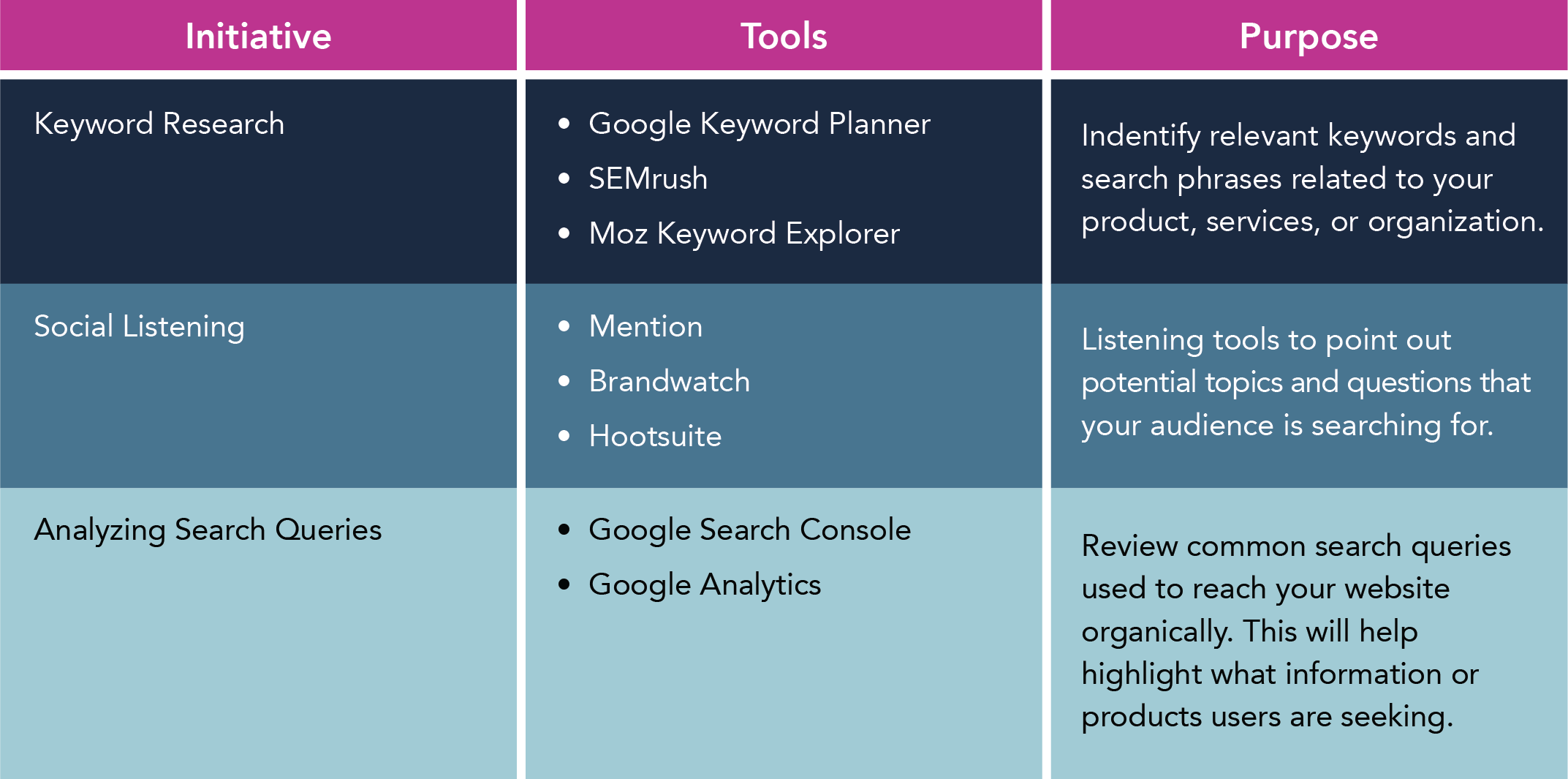With Google making nearly 2,000 changes to its search algorithm each year, more than ever, it’s necessary to understand the heart of the consumer in order to successfully compete in SEO. By utilizing Uses and Gratification Theory and Google’s search intents, business owners and marketers alike can identify the wants and desires of their target audience and create content that meets their needs. Ultimately, resulting in improved search engine ranking and brand awareness.
Consumers Play An Active Role in Media Consumption
Uses and Gratification Theory (UGT) is a mass communications theory that maintains that individuals are not passive consumers of media, but instead actively choose to consume media that fulfills their needs and goals. The theory suggests that people consume media for four reasons.
Informational
People consume informational or surveillance media to further their knowledge and to stay up to date on current events, news, and trends. This type of media ultimately satisfies their curiosity enabling them to make informed decisions.
Personal Identity
Individuals seek media that reinforces their perceived identity, beliefs, and values. Viewers often associate themselves with characters and TV programs, while simultaneously learning social norms and behaviors.
Also known as the “self-esteem” need, consumers perceive their status and credibility based on advertisements or product placement. For instance, compare the societal status that is associated with drinking a Starbucks coffee over a gas station coffee. Although both provide caffeine, imagery of A-list celebrities, Wallstreet bankers, and world leaders drinking their daily Starbucks latte has led to people associating the brand with higher social status. Therefore, by purchasing the same drink, a sense of elite status is placed on the consumer.
Integration and Social Interaction
As communication has evolved alongside technology, media serves the purpose of connecting family, friends, celebrities, and content creators. Social networking sites such as Facebook, Instagram, and TikTok allow users to fulfill their needs of social interaction while building para-social relationships with public figures they relate to.
Entertainment
Seeking escapism from the world, individuals consume entertaining media such as reading books or magazines, watching television or a movie or listening to music on the radio. These outlets allow them to relax and be enveloped in a story or just get away from the stresses of everyday life.
Understanding Google’s Search Intents Can Help Drive Content Strategy
Uses and Gratification Theory also explains why people use search engines and what needs are being met. By understanding Google Search intents, organizations can create an effective and relevant content strategy that addresses the needs of its users, and ultimately rank higher on the search engine results page (SERP). Like UGT, all Google searches can be categorized into four groups.
Informational
Informational intent refers to seeking information or answers to specific questions. These users are searching for specific information: facts, instructions, or explanations on a particular topic. Example searches may include “Who was King Henry the IV?” or “Where is Istanbul?” Overall, users are searching for topics that can expand their knowledge base.
Navigational
The goal of Navigational intent is to locate a particular brick and mortar location or online destination. While looking for a physical location users may search “Where is the nearest park?” or users looking for an online destination may search “Amazon Prime.” It’s important to note that many users prefer to type the name of a business into a search engine, rather than entering a website’s URL. Marketers and business alike will often target this search intent with hyper-local SEO strategies or branded paid media campaigns as these searches show a high intent to convert.
Transactional
Transactional intent involves searches in which an individual Is looking to perform a specific transaction or task. Searches with this intent include powerful action-oriented words. For instance, “book a flight,” “purchase Nike sneakers,” or “pre-save Taylor Swift Album.”
Commercial
Commercial intent refers to searches related to researching products or services prior to a transaction. Users with this intent are in the consideration phase of the marketing funnel but not quite ready to convert until they can confirm that their purchase can provide the best functionality at an appropriate price point. These users are actively researching reviews, Reddit threads, and product offerings. Common commercial searches may include “What’s the best digital camera?,” “Best designer purse,” or “Is the Nintendo Switch worth it?”
Combining UGT and Google Search Intents Helps Marketers Understand Their Audiences
After reviewing Uses and Gratifications Theory and Google’s Search intents, it’s evident that there are many common parallels on why and how a user is defining their needs. Ultimately, UGT can explain the intrinsic needs and wants of a user, whereas Google’s search intents categorize and fulfill those needs into tangible results. By analyzing a user’s motivations from ideation to action, marketers can understand audiences holistically.
UGT and Google Search Intent Can Work Together to Create An Impactful SEO Strategy
To maximize the efficacy of Uses and Gratifications Theory in a Search Engine Optimization (SEO) strategy it’s necessary to take the following steps.
Define Your Goals
First, take a step back and review the overall goals of your organization. SEO is a long-term strategy that can take at least six months to see results. To maximize your efforts, ensure that your efforts align with larger strategic company objectives. Overall, this will allow you to establish a clear purpose and long-term sustainability.
Secondly, define what successfully implementing this strategy will look like for your brand. Complete a current SEO audit and set benchmarks to compare results quarter over quarter.
Third, know your brand and your audience. By defining your brand positioning and audience, you can create relevant and targeted content that resonates with that audience.
Identify the Needs of Your Audience
To effectively identify the needs of your audience, use free or paid tools to conduct keyword research, social listening, and search query analysis.

Create Quality Content
The key to a successful SEO strategy is creating quality content that offers value to your audience. Start by conducting keyword research to identify relevant high-volume, low competition keywords. This will provide insight on what your audience is searching for so you can tailor your content and optimize your ranking. When writing a blog for example, gear your content to focus on providing value through answering questions and addressing concerns. This in return will build trust and authority with your target audience. Additionally, quality content increases the likelihood of acquiring backlinks from other reputable websites, which can boost your SEO ranking. Finally, follow the most up-to-date SEO best practices such as including videos, page titles, and correct headings to ensure that it’s optimized for Google’s web crawler.
Uses And Gratifications Theory (UGT) Provides Meaningful Insight Into The Intrinsic Motivations And Needs Of Consumers
By creating an SEO strategy with UGT in mind, organizations can closely align with the needs and interests of their audience; therefore, increasing engagement and brand affinity. By combining UGT with content geared towards Google’s search intents, marketers can better understand their audiences and create rich, meaningful content resulting in improved visibility and organic traffic.
